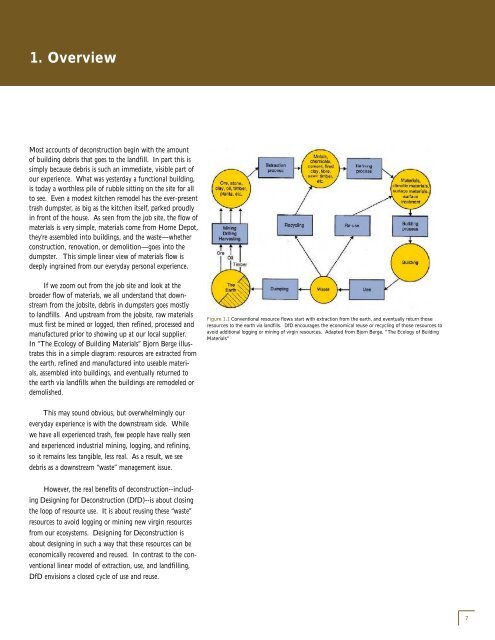Design For Deconstruction - US Environmental Protection Agency
Design For Deconstruction - US Environmental Protection Agency
Design For Deconstruction - US Environmental Protection Agency
Create successful ePaper yourself
Turn your PDF publications into a flip-book with our unique Google optimized e-Paper software.
1. Overview<br />
Most accounts of deconstruction begin with the amount<br />
of building debris that goes to the landfill. In part this is<br />
simply because debris is such an immediate, visible part of<br />
our experience. What was yesterday a functional building,<br />
is today a worthless pile of rubble sitting on the site for all<br />
to see. Even a modest kitchen remodel has the ever-present<br />
trash dumpster, as big as the kitchen itself, parked proudly<br />
in front of the house. As seen from the job site, the flow of<br />
materials is very simple, materials come from Home Depot,<br />
they’re assembled into buildings, and the waste—whether<br />
construction, renovation, or demolition—goes into the<br />
dumpster. This simple linear view of materials flow is<br />
deeply ingrained from our everyday personal experience.<br />
If we zoom out from the job site and look at the<br />
broader flow of materials, we all understand that downstream<br />
from the jobsite, debris in dumpsters goes mostly<br />
to landfills. And upstream from the jobsite, raw materials<br />
must first be mined or logged, then refined, processed and<br />
manufactured prior to showing up at our local supplier.<br />
In “The Ecology of Building Materials” Bjorn Berge illustrates<br />
this in a simple diagram: resources are extracted from<br />
the earth, refined and manufactured into useable materials,<br />
assembled into buildings, and eventually returned to<br />
the earth via landfills when the buildings are remodeled or<br />
demolished.<br />
This may sound obvious, but overwhelmingly our<br />
everyday experience is with the downstream side. While<br />
we have all experienced trash, few people have really seen<br />
and experienced industrial mining, logging, and refining,<br />
so it remains less tangible, less real. As a result, we see<br />
debris as a downstream “waste” management issue.<br />
However, the real benefits of deconstruction --including<br />
<strong>Design</strong>ing for <strong>Deconstruction</strong> (DfD)--is about closing<br />
the loop of resource use. It is about reusing these “waste”<br />
resources to avoid logging or mining new virgin resources<br />
from our ecosystems. <strong>Design</strong>ing for <strong>Deconstruction</strong> is<br />
about designing in such a way that these resources can be<br />
economically recovered and reused. In contrast to the conventional<br />
linear model of extraction, use, and landfilling,<br />
DfD envisions a closed cycle of use and reuse.<br />
Figure 1.1 Conventional resource flows start with extraction from the earth, and eventually return those<br />
resources to the earth via landfills. DfD encourages the economical reuse or recycling of those resources to<br />
avoid additional logging or mining of virgin resources. Adapted from Bjorn Berge, “The Ecology of Building<br />
Materials”<br />
7

















